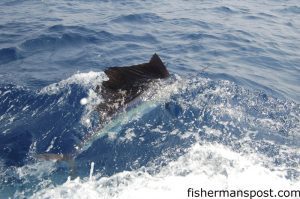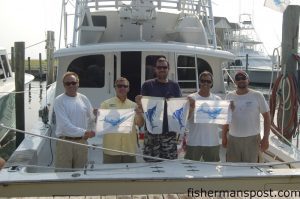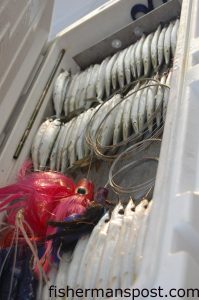Teased And Released

A sailfish that couldn't resist a naked, circle hook-rigged ballyhoo trailing a dredge teaser in the wake of the charterboat "Bite Me" awaits leadering, revival, and release.
Glittering like a pair of crystal chandeliers in the midday sun, two dredge teasers made their luminescent presence known on either side of the wake of the 51’ BC custom sportfisherman “Bite Me.” The flashy attractors had already put in work, attracting attention from several sailfish before the sun had climbed high enough to give those of us aboard the boat a clear view of the hookless offerings running a few feet below the surface.
The Fish Post crew had managed to steal a day from the demands of putting out an issue and made a late-night run to Hatteras Village, where we rendezvoused the next morning with “Bite Me” skipper Capt. Jay Kavanagh and mate Jeremy Hicks at Hatteras Harbor Marina. The sun was just peeking from the horizon behind Hatteras Lighthouse as we made our way out Hatteras Inlet and into the light ground swell left over from the previous day.
“We didn’t fish yesterday,” Jeremy explained as Jay pointed the boat’s big bow on a southerly course, “but the boats that did had 14 sailfish and a white marlin down to the southern, out in around 50 fathoms.”
Jeremy had been busy on the ride out, rigging ballyhoo, checking drags, preparing the dredges, answering the questions we peppered him with, and plenty of other tasks, but he turned into a blur of motion as Jay pulled back the throttle around the 980 Loran Line south of Hatteras Inlet.
In moments, he had the dredges in the water (one rigged with dead mullet, one a holographic set of Stripteasers), a pair of circle hook-rigged dink ballyhoo swimming above and just behind them, two more dink baits further back on the outriggers, and a pair of larger ballyhoo/Ilander combinations running between them. A squid daisy chain outside the port dredge added even more in the way of “tease” to the spread.
With the finishing touches put on his spread and all rods where they belonged (Jay likes to fish the outrigger rods from the bridge), Jeremy patiently listened and answered while I asked question after question about the “Bite Me” billfish approach.
The mate rigs his dink baits with a monel wire loop that slides on to a circle hook, exiting either on top or in front of the ballyhoo’s bill, depending on where they’re destined for in the spread.
“See how the long rigger baits aren’t swimming?” Jeremy asked me, gesturing to the two baits trailing from the outriggers. “They’re splashing on top. I don’t break their backs or prepare them as much as the flatline baits, and they last a lot longer that way.”
Rigged with the hook attached straight in front of the baits’ bills, the rigger baits indeed skipped their way across the surface, looking very much different than the naked flatline ballyhoo paddling their tails off a few inches under the surface. With the hook attached on top of the baits’ bills and further back, the ballyhoos’ heads act as a bit of a diving lip, keeping them under the surface and undulating back and forth seductively.
“Everybody does this different,” the mate continued, “but I like to give them something different to look at than four swimming baits.”
“The skirt keeps that going,” he added when I inquired about the pink squid skirt on one of the rigger bait’s noses. “Sailfish love pink, and it just gives them a bait with a little different appearance than four nakeds.”
The larger ballyhoo running under Iland lures, blue/white on the port side and pink on the starboard, were rigged with J-hooks on heavy wire leaders for a fighting chance in case a wahoo or a blue marlin crashed the party.
“Of course, they bite the dinks more often than not anyway,” Jeremy added.
The mate had explained his method of hooking billfish on the dink baits on the ride out, and it wasn’t long before we got to see it in action.
“There he is,” Jay excitedly shouted from the bridge. “He’s on the flat line!”
Jeremy had the rod in his hand before the captain had the words out of his mouth, and I watched as a sailfish bill tore through the surface behind the naked ballyhoo trailing the mullet dredge. Jeremy’s flatline bait was swimming so hard it looked as though it might get away from its billfish pursuer for a moment, but a quick slash of the bill popped the line free of the clip on the transom and the game was on.
When dink bait fishing, the mate keeps the TLD 20 reels in free-spool, with the clickers on to prevent a backlash.
“The first thing is to point the rod at the fish and take the clicker off,” Jeremy had explained, “and keep your thumb really gently on the spool because you don’t want to over run the reel.”
The mate was providing a demonstration of his earlier words, rod pointed back into the wake as the fish accelerated away from the boat.
“The fish has got to turn for that circle hook to work,” he continued, “and you’ll feel him start to dig away from you. As long as he’s still taking line off, I increase the drag slowly after I count off about 5-7 seconds.”
The “Bite Me” dink rods are only set at 4 lbs. of drag at strike, and Jeremy slowly advanced the TLD’s lever until he got there. As he did, the rod gradually took a bend and the sailfish emerged, offering us a series of head-shaking leaps off the wake’s starboard side while Jeremy passed the rod off to Gary.

Capt. Jay Kavanagh, Eddie Hardgrove, Max Gaspeny, Gary Hurley, and mate Jeremy Hicks display the flags earned by releasing a quartet of sailfish that couldn't resist naked ballyhoo trolled behind dredge teasers in the wake of the charterboat "Bite Me."
After leaving the baits on the opposite side of the spread in the water in the hopes of drawing another bite while Gary’s fish tore off line and kept up the aerial display, Jay and Jeremy cleared the lines and Jay began a turn to bring the fish off the sportfisherman’s transom. The turn brought the fish closer to the boat, and Gary cranked the TLD’s handle furiously in an effort to keep up.
The Publisher continued the effort, keeping a tight line while the boat spun, and the sailfish for a time stayed in the water. For a moment, it looked like Jeremy would be able to grab the leader and make the release official, but the fish had other immediate ideas.
It took to the air again, greyhounding away from the boat as it ripped the line Gary had fought to recover back from the reel.
As it usually goes, this run was shorter than the first, and the sailfish calmed down a bit after the aerial stunt.
With Jay backing down on the fish, Gary again winding like mad, and Jeremy donning gloves, the leader was in hand moments later and the catch was in the books.
After getting the sail alongside the port covering board, the mate leaned over the gunnel to ease the circle hook from the corner of the fish’s bony mouth.
He held the sailfish by the bill as Jay eased the boat forward again, giving the tired creature a little time to recover from the battle.
Jay and Jeremy had offered to pull the fish into the boat for a photo, but they were clearly happy when we said we’d like to leave it in the water.
“Somebody said something to me that made a lot of sense,” Jeremy explained. “Imagine running a marathon, then having somebody hold your head under water. That’s exactly what it would be like for a sailfish you pull in the boat.”
Half a minute later, the fish was rejuvenated, and as Jeremy let go of the bill, it took a hard tail kick, swimming off with sail and tail extended from a rolling swell before departing heartily back into the blue depths.
With a sailfish release less than an hour into our troll, everybody aboard the boat was pumped. Jeremy and Jay quickly had the spread back in the water and looking good, and I felt confident enough after seeing it done once that I set back out the starboard flatline.
“Right there,” Jeremy said to me as the dink bait took up position behind the Stripteaser. “Give it 13 twists before you put it in the clip for luck.”
I did as told, watching Jeremy climb the ladder to the bridge to satisfy another “Bite Me” superstition.
“Captain and mate have to high-five after a billfish,” Jay explained after giving Jeremy a double hand slap.
It wasn’t long until our next sailfish encounter, this time with multiple assailants. As Jay shouted out another fish rising on one of the flatlines to Jeremy, a second came up on one of the rigger baits, and captain and mate each flawlessly hooked a fish. We were in the process of taking the rods off their hands when a third sail rose on the remaining flatline bait.
The third fish refused to fully commit, but the double header was on. Jay chose to head the boat for the fish first, as it was closer than mine, which had stopped running to take a single leap, but quickly returned to its original agenda.
Paying attention to my fish, I didn’t have time to keep up the first fish’s struggle, but heard the exultation as the mate got a hand on the leader behind me.
Jeremy helped the sail kick off into the blue a short time thereafter, and the crew became focused on my fish which was still creeping line off the reel.
“Where are you, Max?” Jay queried, following the hi-vis yellow line from the bridge.
“A long way out,” I responded. “He never stopped going.”
Getting a visual on the angle of the line, Jay put the boat into a turn, and for the first time since I’d taken the rod, I was able to put a little line back on the dwindling spool.
After watching Gary reel fiendishly on his fish, it was my turn, and I wound at top speed, feeling the burn in my forearm as the spool grew wider.
“We’ve still got a lot of line out,” Jeremy said to the helmsman as I continued the hurried pace. He’s almost back to half a spool, but we’re tight on the fish.”
Jay quartered towards the sail, closing the gap on the fish, and the bright line continued coming my way.

The early light on naked "dink" ballyhoo and several ballyhoo/lure combinations in Jeremy Hicks' bait tray as they await meetings with blue water predators later in the morning.
“There he is, boys!” Jeremy shouted as Jay turned to put the fish off the transom. “Right out there. He’s jumping!”
A trio of leaps left foamy entry and exit holes in the ocean, but they also seemed to tire the fish a bit, and with a little help from a large diesel motor in reverse, the leader soon emerged from the water.
“Get that leader into the rod tip,” Jeremy exhorted, and I was able to, making the catch official.
“Now take one step back,” the mate continued, grabbing the leader as I stepped back from the gunnel.
The revival and release routine again went swimmingly, and the sail was soon doing some swimming of its own, eager to put some distance between itself and the boat to get back to harassing schools of baitfish.
Finding sailfish off Hatteras Inlet, like anywhere, is a game of finding the bait.
“You’re trying to find bait up off the bottom,” Jay explained, while I took advantage of some downtime to get a look at our spread from the bridge. “I’ll set the bottom machine to look in the top 20, 30, or 40 fathoms of the water column. If you’re marking it at 50-60 fathoms or deeper, chances are they’re not going to hear us and come up.”
The Hatteras charter fleet also works closely together to locate and hook fish.
“Everybody up here works really well together,” the captain continued, eyes back and forth between the bottom machine and the boat’s wake. “If they start seeing some sailfish on up the way, they’ll let us know and we’ll head over there. Omie Tillett, who was kind of the godfather of this charter fleet, used to say it was a lot better for everybody to catch a few fish than for one boat to have a big catch and everybody else none, and we stick to that.”
In addition to targeting billfish like sails and blue and white marlin, the “Bite Me” crew fishes for bluefin tuna in wintertime, yellowfins in spring and fall, as well as gaffer dolphin, trophy king mackerel, and just about anything else that plies the blue water off Hatteras. Capt. Jay Kavanagh and mate Jeremy Hicks are not only a pair of very skilled fishermen, they have what all sportfishing operations need to be successful—they’re great company, keeping everyone aboard entertained even when the bite slows down.
Contact them about a trip of your own by calling Jay at (252) 996-0295 or visit www.fishbiteme.com for more details.





